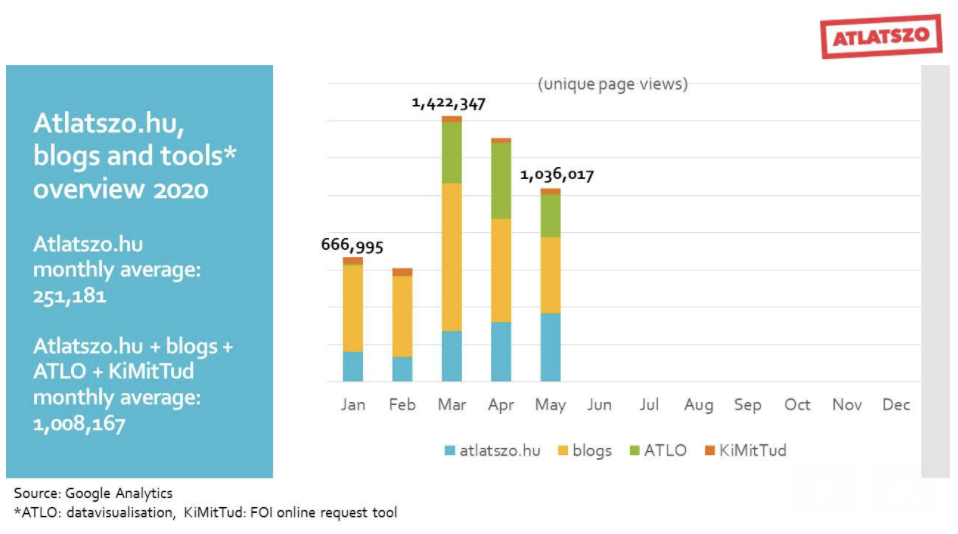This case study is part of Resilience Reports, a series from the European Journalism Centre about how news organizations across Europe are adjusting their daily operations and business strategies as a result of the COVID-19 crisis.
In a nutshell: A data visualization landing page combining the best of Átlátszó’s data journalism and investigative stories not published elsewhere saw traffic more than double.
When the pandemic hit Hungary, Viktor Orbán’s government used it as an opportunity to further assert its control on the media.
The central Eastern European state was selective about what was communicated publicly and even passed a law that threatened journalists with jail time. Subsequently, most Hungarian news outlets — many of which are owned by allies of the government — avoided criticizing how the health crisis was handled.
For one independent investigative outlet, nine-year-old Átlátszó, it proved a key moment. Its team of journalists and data specialists developed a live “koronamonitor” to visualize virus trends and even worked with an academic researcher to try and predict various COVID-19 scenarios. Their efforts resulted in traffic to the site increasing by 133%.
The European Journalism Centre’s Tara Kelly asked Átlátszó’s executive director about why it took such a data-led approach and what it learned along the way.
What is Átlátszó?
Átlátszó is Hungary’s first nonprofit dedicated to investigative journalism and freedom of information. Its name means ‘transparent’ in English.
Established in 2011, it covers political corruption, campaign financing, financial abuse in public office and human rights violations through investigative reports and freedom of information requests. In some cases, it embarks on freedom of information lawsuits where its requests are refused. The aim of Átlátszó is to shed light on scandalous misuse of political and economic power and influence in Hungary.
Based in Budapest, Átlátszó employs a full-time staff of seven — five are journalists and two are project managers. This core team is supported by 40 contractors, including video and data journalists as well as legal and IT support. It also has a data journalism and visualization unit, the first of its kind in Hungary, which is called ATLO and supports its investigative and data journalism activities.
Átlátszó operates a number of tools to further its mission, including a Tor-based anonymous whistleblowing platform and a freedom of information request generator to make the process easier for the general public.
Átlátszó relies on crowdfunding from readers (60% of its budget) and international charitable donors (40%). Some of its funders include the Open Society Foundations, Sigrid Rausing Trust, Global Anti-Corruption Consortium, Fritt Ord, and Visegrad Fund. The organization has zero commercial revenues and offers no advertising. All content is free for all readers.
Every year, Hungarian taxpayers are eligible to donate 1% of their personal income tax to a charity of their choice at no additional cost. Through its website and newsletters, Átlátszó encourages readers to donate their 1% to them. Around 3,000 people donate their tax to the organization and a similar number make small monthly contributions of €3 per month. Donations are anonymous so it is unclear if there is any crossover between these groups.
Press freedom in Hungary has rapidly deteriorated over the past decade — about 90% of all media is government-controlled in some form. Hungary ranked 89 in the annual Reporters Without Borders 2020 World Press Freedom Index, down from 56 in 2013.
On March 30, the Hungarian government passed new legislation that reporters say is being used to deny journalists access to information and could see them jailed for up to five years if convicted. This has led to fewer news outlets reporting critically about COVID-19 and more self-censorship. For Átlátszó, it has meant the team is extra careful with fact-checking and verification before publishing anything.
Átlátszó surveys its audience every year. According to its research, its core audience lives in the capital, is highly-educated and seeks a more open public discourse in Hungary.
In 2019, its websites reached a regular readership of 500,000-900,000 unique views per month. According to Medián Research — one of the country’s top research firms — this represents around 15% of Hungary’s daily internet users visiting at least once a month.
Átlátszó writes two weekly newsletters, one in Hungarian (2,500 subscribers, open rate of 15-25%) and one in English (1,500 subscribers, open rate of 30%). It also distributes stories via its Facebook page, which has over 100,000 followers.
How did Átlátszó handle the COVID-19 crisis?
During the two months of lockdown, Átlátszó continued to publish 3-5 short articles a day and 3-5 features a week. However, these articles included investigations on how the pandemic was impacting Hungary.
In March, one report showed how the Hungarian government gave more money to protect churches and invest in its opera house than to curb the coronavirus. Another investigation revealed how a relative of a politician started to profit from medical supplies and disinfectants. The Átlátszó team was also the first news organization to write about company layoffs in Hungary.
In one such case, after publishing a story about a car parts supplier laying off 100 workers, the supplier reported Átlátszó to the police for spreading fear during the pandemic. The company filed a criminal complaint, but no official proceedings were followed up.
In March, ATLO launched a landing page — dubbed the “koronamonitor” — with daily statistical updates, graphs and maps about the state of the coronavirus outbreak in Hungary. When it was first published, pro-government media accused Átlátszó of distorting the numbers. The team responded by writing blog posts explaining that the visualizations were based on official government numbers. Átlátszó also produced a weekly coronavirus data feature article looking at trends with the official statistics. Since June, the landing page has been updated weekly, as Hungary’s COVID-19 case rate and death toll has dropped.
There was huge demand for forecasts on COVID-19 and how the pandemic might proceed. The data journalism team also used a mathematical model produced by Dr. Tamás Nepusz from Molde University in Norway to estimate how many may be infected in Hungary in May. Later Átlátszó introduced an interactive pandemic simulator where the audience was able to set different parameters and see how it would affect the virus forecasts.
Átlátszó operated in a difficult environment during COVID-19 as hospital staff were expressly banned from speaking to the press. This meant the team received anonymous leaks about topics including the shortage of masks and the unreliability of the rapid COVID-19 tests imported from China. Most recently, they published an anonymous diary from a health care worker explaining what it was like to work in a hospital during the height of Hungary’s pandemic.
To ensure safety, the team maintains a strict policy of not using a mobile phone and of communicating solely via secure email. It also advises sources to use Gmail or Protonmail as well as other encrypted chat and voice applications like Signal, Viber or WhatsApp.
Átlátszó’s website saw unique visitors more than double from 600,000 in February to 1.4 million in March. Traffic rose when the team published COVID-19 stories that the mainstream media weren’t reporting on. For example, its most popular piece during COVID-19 was about a relative of a politician from Fidesz, Viktor Orbán’s right-wing party, profiteering on shortage of medical supplies. The Hungarian version of the article reached 72,000 shares on Facebook.
The team believes that publishing stories the Hungarian mainstream media weren’t covering — such as the reorganization of hospitals — made the site a destination for concerned citizens. Traffic in April dropped to about 1.3 million unique visitors and then just over a million visitors in May.

(Courtesy: Átlátszó)
The organization saw a handful of people canceling their microdonations out of over 3,000 donors. This is likely due to the economic uncertainty as people may continue to fear being laid off. Átlátszó doesn’t yet know how donations have been impacted by the pandemic’s economic blowback as the government only releases information about the 1% tax donations in September.
How has COVID-19 changed the future of Átlátszó?
When Átlátszó started crowdfunding in 2011, no other Hungarian media was asking their readers for donations. Today, all independent media in Hungary do crowdfunding, making the market much more competitive and harder for Átlátszó to raise funds from readers. Pressure on international donors to help out independent Hungarian media has increased in recent years. This means Átlátszó expects more competition for crowdfunding and international donors as well.
Átlátszó will continue to work with the data journalism team. The success of the “koronamonitor” has demonstrated the power of data journalism to stand on its own. While there is no extra resources to invest in the team, they want to find more data-led stories that can add to the depth of their coverage.
Átlátszó’s mission remains the same. It will continue to publish stories on COVID-19 and hold the government to account. The new fake news law in Hungary means the team has to continue to report very carefully and to focus on fact-checking. They continue to work with lawyers and fight attempts to silence their work.
What have they learned?

(Courtesy: Átlátszó)
“Investigative reporting on COVID-19 was in high demand since most of the Hungarian press did not cover the pressing issues during the lockdown. We have learned if you have enough courage to report on problems during a crisis your audience will reward you. The ‘koronamonitor’ was by far the most successful data journalism feature we ever did. This made us realize that data journalism can be very important to our work. Prior to this, we saw data journalism as a ‘nice to have’ add-on feature but not a necessity. This was the first case where data journalists played a central role on Átlátszó and was the most important element of our coronavirus content. This means we will look for news topics that can be visualized and explained in a similar way.”
– Tamas Bodoky, executive director, Átlátszó
Additional reading
- Mérce grew its digital readership by 30% by doubling down on the everyday effects of COVID-19. Here’s how. (Medium)
- Central and Eastern European journalists collaborate to counter propaganda (International Journalists’ Network)
- Reporting beyond the case numbers:How to brainstorm COVID-19 data story ideas (DataJournalism)
This case study was produced with support from Evens Foundation. It was originally published by the European Journalism Centre on Medium and is published here under the Creative Commons Attribution-NonCommercial-ShareAlike 2.0 license. The Poynter Institute is also the fiscal sponsor of the Verification Handbook.






